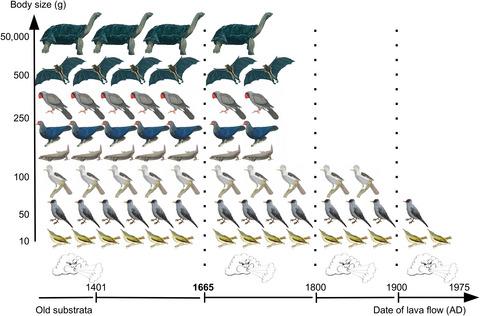Our official English website, www.x-mol.net, welcomes your feedback! (Note: you will need to create a separate account there.)
Collapse of dispersal trait diversity across a long‐term chronosequence reveals a strong negative impact of frugivore extinctions on forest resilience
Journal of Ecology ( IF 5.5 ) Pub Date : 2020-02-24 , DOI: 10.1111/1365-2745.13359 Sébastien Albert 1 , Olivier Flores 1 , Dominique Strasberg 2
中文翻译:

长期时间序列上散布性状多样性的崩溃揭示了节食动物灭绝对森林适应力的强烈负面影响
更新日期:2020-02-24
Journal of Ecology ( IF 5.5 ) Pub Date : 2020-02-24 , DOI: 10.1111/1365-2745.13359 Sébastien Albert 1 , Olivier Flores 1 , Dominique Strasberg 2
Affiliation

|
- Understanding how seed dispersal disruption may alter plant community diversity and dynamics over a large temporal scale remains a challenge. Here, we use a long‐term chronosequence to compare changes in the richness and composition of different dispersal trait assemblages in communities established before and after human colonization in the Mascarene archipelago.
- Our study was located on Réunion on the slopes of the Piton de la Fournaise which is one of the most active volcanoes worldwide. We analysed 151 vegetation surveys on lava flows dated between 1401 AD and 1956 AD and in tropical rainforests established on older substrata. We defined five classes of substratum age, according to the well‐known chronology of native frugivore defaunation: ‘old substrata’ and [1401, 1665[ when frugivores were abundant and diverse before permanent human settlement; [1665, 1800[ when large‐bodied frugivore populations were strongly reduced; [1800, 1900[ when large‐bodied frugivores went extinct and small‐bodied frugivores were still abundant; [1900, 1956] decline in the populations of small‐bodied frugivores. Based on dispersal traits, we categorized 146 native woody species as anemochorous, small fleshy‐fruited or large fleshy‐fruited, i.e. plant of which fruit could not theoretically be dispersed by extant frugivores.
- Changes in dispersal trait diversity strongly correlated with the chronology of defaunation. Species‐rich communities settled before human colonization was strongly dominated by fleshy‐fruited species. Large fleshy‐fruited plants in the oldest communities settled after human colonization declined markedly and almost disappeared after 1800. The richness of small fleshy‐fruited plants decreased less rapidly across the chronosequence, with medium levels on [1665, 1800[ and [1800, 1900[ lava flows and low levels on [1900, 1956] lava flows. Conversely, the richness of anemochorous plants remained unchanged. Communities settled before human colonization had a similar composition. Fleshy‐fruited assemblages showed strong species loss across the chronosequence, while anemochorous assemblages showed strong species turnover, which was probably due to lower dispersal limitation.
- Synthesis. Our results provide the first insights into the tremendous impact that frugivore extinction has on plant colonization dynamics over 300 years. The dramatic loss of fleshy‐fruited plant diversity on historical lava flows highlights the irreplaceable dispersal role played by frugivores, especially large‐bodied species. The conservation of plant–animal mutualistic interactions is invaluable and refaunation efforts need to be undertaken in areas where frugivores have been extirpated.
中文翻译:

长期时间序列上散布性状多样性的崩溃揭示了节食动物灭绝对森林适应力的强烈负面影响
- 了解种子散布的破坏如何在较大的时间范围内改变植物群落的多样性和动态仍然是一个挑战。在这里,我们使用长期时间序列来比较在人类在玛斯卡林群岛定居前后建立的社区中不同分散性状组合的丰富度和组成的变化。
- 我们的研究位于皮奥·德拉·富纳瓦(Piton de la Fournaise)斜坡上的留尼汪岛,该山脉是全球最活跃的火山之一。我们分析了公元1401年至1956年之间熔岩流以及在较老的地层上建立的热带雨林中进行的151次植被调查。根据众所周知的原生节食动物消灭的年代,我们定义了五种底层年龄:“老底层”和[1401,1665 [当食肉动物在人类永久定居之前丰富而多样;[1665,1800 [当大果蝇的数量大大减少时;[1800,1900 [当大果蝇灭绝而小果蝇仍然丰富时;[1900,1956]小型食肉动物的数量下降。根据传播特征,我们将146种原生木本物种归为绒毛,
- 分散性状多样性的变化与消散的时间顺序密切相关。在人类殖民化之前,物种丰富的社区已经定居,而果肉的物种在这里占据了主导地位。最早的群落中的大型果肉植物在人类定居后显着下降并在1800年后几乎消失之后定居。小型肉果植物的丰富度在整个时间序列上下降的速度较慢,在[1665、1800 [和[1800,1900] [熔岩流和[1900,1956]熔岩流的低水平。相反,离毛植物的丰富度保持不变。在人类殖民化之前,社区已经定居。在整个时间序列中,多肉类组合显示出强烈的物种损失,而绒毛类组合显示出强大的物种更新,
- 合成。我们的结果首次揭示了食腐动物灭绝对300多年来植物定植动态的巨大影响。历史上的熔岩流使肉质植物多样性急剧丧失,这突出了节食动物,尤其是大物种的不可替代的传播作用。保护植物与动物的相互影响是非常宝贵的,需要在已经灭绝食草动物的地区进行修复工作。



























 京公网安备 11010802027423号
京公网安备 11010802027423号